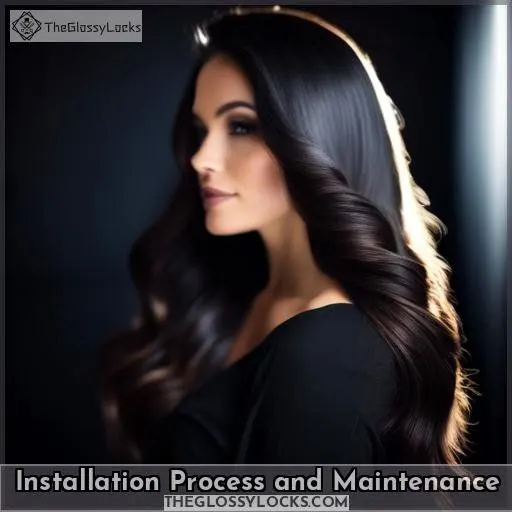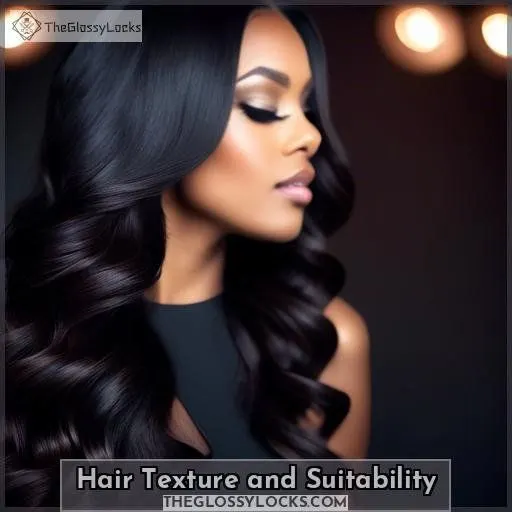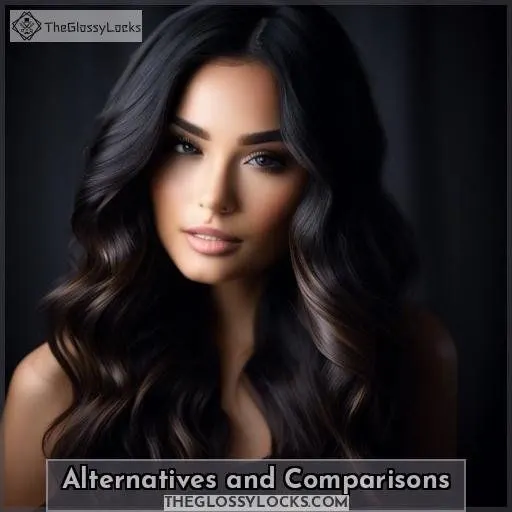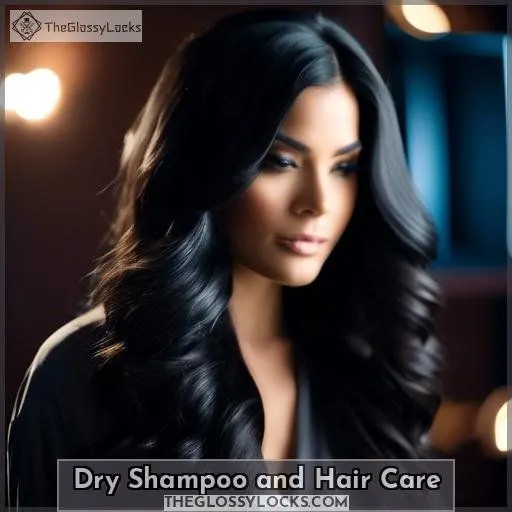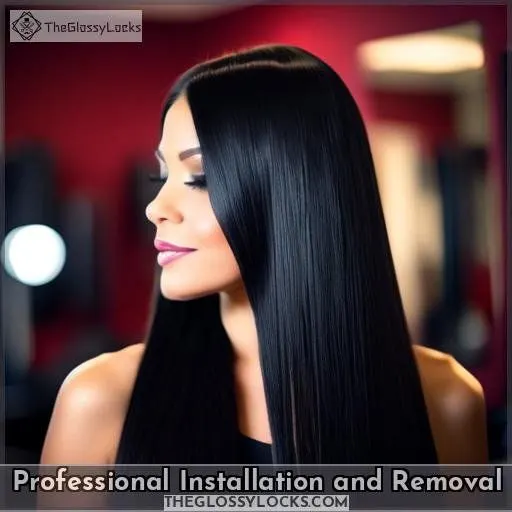This site is supported by our readers. We may earn a commission, at no cost to you, if you purchase through links.
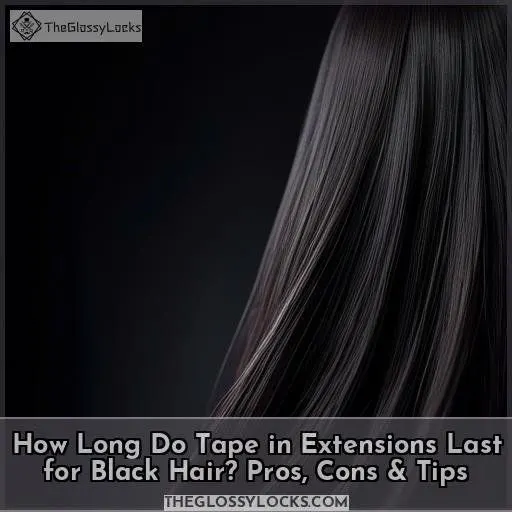
For your textured black hair, tape-in extensions can last 8-10 weeks with proper installation and care.
Match the hair texture closely for a seamless blend and longevity. Pre-taping allows easy application, but expert sectioning is essential to distribute the weight evenly.
Use alcohol-free shampoo, avoid oils near the adhesive, and keep the tape strip clean. While convenient, improper installation risks traction alopecia.
Explore other protective styles too. High-quality human hair extensions reduce damage and blend naturally when installed by a professional.
The crucial factors determine how long your tape-ins can last – and you’ll gain more insights ahead.
Table Of Contents
- Key Takeaways
- How Long Do Tape in Extensions Last Black Hair?
- Longevity and Lifespan
- Installation Process and Maintenance
- Hair Texture and Suitability
- Alternatives and Comparisons
- Benefits and Risks
- Initial Reactions and Experiences
- Things to Keep in Mind
- Dry Shampoo and Hair Care
- Professional Installation and Removal
- Quality and Cost Considerations
- Frequently Asked Questions (FAQs)
- Conclusion
Key Takeaways
- Proper installation and care are crucial for the longevity of tape-in extensions, with a lifespan of 8-10 weeks on average.
- High-quality human hair extensions can last longer and blend naturally when installed by a professional.
- Improper installation or removal can lead to damage, including traction alopecia.
- Alternatives to tape-in extensions, like clip-ins and sew-in wefts, offer different benefits and risks for those seeking a voluminous, natural look.
How Long Do Tape in Extensions Last Black Hair?
Tape-in extensions are designed to last for four to eight weeks, depending on how well they are cared for.
Longevity and Lifespan
Tape-in extensions are sought after by those seeking to enhance their hair’s length and fullness. But how long do they hold up? The lifespan of these extensions is governed by various factors, such as their quality, new hair growth, and removal methods.
On average, tape-in extensions endure for 8-10 weeks. However, this duration may fluctuate depending on the person’s hair type and how well they’re cared for. Extensions of superior quality can outlast those of inferior quality.
When it comes to removal, using a specialized solution is critical to avoid scalp damage. Improper removal can harm the scalp, potentially leading to hair loss.
To extend the lifespan of tape-in extensions, steer clear of applying oil to the scalp, as it can weaken the adhesive. Regularly wash your hair using an alcohol-free shampoo and maintain the adhesive strip free of dirt and moisture.
If you’re mulling over tape-in extensions, it’s imperative to acknowledge that they aren’t a protective style. Your natural hair will be exposed, so mull over your hair objectives before committing.
Installation Process and Maintenance
Tape-in hair extensions are a popular option for those seeking to add length and volume to their hair without the need for tools or chemicals. They’re virtually undetectable, lying flat against the head and blending seamlessly with natural hair. However, proper installation and maintenance are essential for their longevity and to prevent damage. Here are some tips for caring for your tape-in hair extensions:
- Pre-taped application: Tape-in extensions come pre-taped with medical-grade glue, making the installation process simple and quick.
- Scalp weight: Be mindful of the weight of the extensions on your scalp, as they can add pressure and potentially cause discomfort or damage.
- Natural appearance: To achieve a natural appearance, tape-in extensions should be installed in sections, with volume added for a fuller look.
- Versatility in styling: Tape-in extensions can be styled, colored, and treated just like your own natural hair, allowing for versatility in styling options.
Remember to follow these guidelines for best results:
- Installation process: Apply tape-in extensions as close to the root of your natural hair as possible, spaced evenly throughout your head.
- Maintenance: Wash your hair with tape-in extensions installed using alcohol-free shampoo and a wide-tooth comb to avoid tangling.
- Damage prevention: Avoid getting the bonds wet for the first 48 hours after installation, and be gentle when handling the extensions to prevent damage.
Hair Texture and Suitability
Regarding tape-in extensions for African American hair, the secret to longevity and quality is matching the hair texture. Tape-in extensions come in various lengths and textures, from Type 1 to 4, guaranteeing a perfect fit for your natural hair. For clients with curly hair, a blowout or silk press might be necessary for a long-lasting, straightened appearance. Wavy and curly textures may reveal the natural texture as new growth occurs, so aligning with your natural hair type is essential for lasting results.
If you have a dry scalp, tape-in extensions may not be the ideal choice, as they can cause discomfort and potentially harm the scalp. However, naturalistas who exercise can still wear tape-in extensions, just make sure to use a blow dryer on a cool setting after exercising and blow-dry the roots thoroughly before combing or washing. Always verify that the tape is completely dry before handling the hair to prevent damaging the adhesive.
When buying tape-in extensions, choose human hair for quality and durability. Remember, tape-in extensions aren’t advised for people with dry scalp, but they can be a great option for those who want to add length and volume to their hair without causing damage. Just be sure to maintain them properly and have them installed by a professional to minimize the risk of damage.
Alternatives and Comparisons
When contemplating alternatives to tape-in extensions, there are numerous choices available for achieving a voluminous, natural look without the potential harm. Some of the most popular alternatives include clip-ins and sew-in rows**.
Clip-ins are extensions that are attached to small clips and can be worn by securely clipping them onto your hair. These extensions come in separable units and can be worn in different sections of your hair. They’re easy to apply and remove, making them a convenient choice for those who want to add length and volume without the commitment of a more permanent extension. Clip-ins are also generally less expensive than tape-ins and can be a more budget-friendly option.
Sew-in rows, on the other hand, are extensions that are sewn directly onto braided hair with a thread and needle. This method provides a fuller appearance and is considered safer for those with sensitive scalps, as it requires no glue or heat for installation. Sew-in extensions are also more durable and can last for several months with proper maintenance. However, the installation process can be time-consuming, taking around 3-6 hours, and may not be suitable for those with very short or oily hair.
Ultimately, the choice between tape-in extensions, clip-ins, and sew-in rows hinges on your personal preference, lifestyle, and hair type. It’s essential to keep in mind factors such as the level of maintenance required, the potential for damage, and the desired look before making a decision. Consulting with a professional stylist can also help you ascertain which option is best for your hair and goals.
Benefits and Risks
Tape-in extensions can be a convenient and versatile option for achieving voluminous and lengthy styles with your natural hair. However, you’ll want to carefully consider the potential risks, like traction alopecia or hair breakage if not properly installed and maintained, as well as explore alternative protective styles that may better suit your hair goals.
Longevity and Quality
Tape-in hair extensions are designed to last for 8-10 weeks, with their lifespan depending on the new growth and extension quality.
However, they need to be removed by a professional using a specific tape-in remover solution** to avoid damaging natural hair.
High-quality human hair extensions, like those from Glam Seamless, provide a more natural appearance and are less likely to cause damage.
It’s crucial to maintain tape-in extensions with proper hair care, such as using alcohol-free shampoo and keeping the adhesive strip clean.
Installation and Maintenance
After delving into the longevity and quality of tape-in extensions, let’s address the fundamentals of installation and upkeep. Mastering taping techniques and sectioning methods provides even weight distribution, enabling limitless styling options. Remember, these marvels require professional installation and maintenance every 8-10 weeks. The removal process is effortless, preserving your hair’s pristine condition. Embrace the transformation with tape-in extensions!
Risks and Alternatives
Tape-in extensions are a popular choice for black women seeking versatility and volume without damaging their natural hair. However, they come with risks such as damage to afro hair if not maintained properly and scalp irritation. To minimize these risks, consider alternatives like clip-ins or sew-in rows. Here are three alternatives to tape-in extensions:
- Clip-ins: These provide a voluminous, natural look without damage or the risk of traction alopecia.
- Sew-in rows: A sew-in weave can be a great option for those with relaxed or texturized hair, offering a more secure and long-lasting installation.
- LA weave: A braidless sew-in, the LA weave provides convenience and less hassle compared to tape-ins.
Initial Reactions and Experiences
Initial reactions to tape-in extensions are often a mix of excitement and nervousness. The freedom and versatility they provide are appealing, but there are concerns about damage to natural hair if not maintained properly. Users report no damage so far and treat the extensions like their own hair. They also suggest adjusting the position of the extensions for a better fit next time.
Tape-in extensions are popular for their ease of use and variety of textures available. They can be removed using a 99% alcohol-based solution, leaving natural hair undamaged. However, they can cause damage if not maintained properly, and aren’t recommended for relaxed or texturized afro hair.
Alternatives to tape-in extensions include clip-ins or sew-in rows for a voluminous, natural look without damage. LA weave (braidless sew-in) provides convenience and less hassle. Texture release may be required before installation to match the natural texture.
Things to Keep in Mind
When contemplating tape-in extensions for black hair, several factors warrant attention. Firstly, it’s paramount to select the appropriate tape variety and color match for your hair texture. This guarantees an organic appearance and reduces potential damage. Styling versatility is also critical, as tape-ins offer diverse styling options, including volume enhancement or length extension. Weight management** is another consideration, as tape-ins may add weight to the scalp, necessitating adjustments.
Cost analysis is another aspect to factor in. Tape-in extensions can be expensive, so it’s essential to assess their longevity and the expenses associated with upkeep and professional removal. Regular maintenance, encompassing washing and heat protectant application, is indispensable to preserve the extensions’ quality and prevent deterioration.
Finally, it’s imperative to establish the lifespan of tape-in extensions with proper washing and the appropriate removal technique. Can tape-in hair extensions be reused, or do they require replacement after each use? Understanding these factors will aid you in making an informed decision about the suitability of tape-in extensions and how to care for them effectively.
Dry Shampoo and Hair Care
Dry shampoo is a vital part of maintaining tape-in extensions. It helps to absorb oil and keeps your hair looking fresh between washes. However, it’s essential to use the appropriate type of dry shampoo and apply it correctly to avoid damaging your extensions. Here are some tips on how to use dry shampoo with tape-in extensions:
- Choose the appropriate dry shampoo: Opt for a mild, alcohol-free formula that’s specifically designed for hair extensions. Avoid using dry shampoo with sulfates, as they can strip the hair of its natural oils and cause damage.
- Apply the dry shampoo: Spray the dry shampoo directly onto your scalp, focusing on the areas where you have the most oil buildup. Make sure to keep the can at least 4 to 6 inches away from your scalp to prevent the dry shampoo from touching your extensions.
- Let it sit: After applying the dry shampoo, allow it to sit for a few minutes to give it time to absorb the oil. This will help to prevent any residue from building up on your extensions.
- Massage it in: Use your fingers to gently massage the dry shampoo into your scalp, making sure to distribute it evenly. This will help to prevent any buildup or a chalky look.
- Use it before going to bed: If you want to wake up with voluminous locks, apply your dry shampoo before going to bed and then style your hair as usual.
Professional Installation and Removal
Delving into the realm of tape-in extensions is akin to entering a creative haven, where every nuance from the adhesive quality to the artistry of application techniques holds significance.
Envision your hair as a blank canvas, and these extensions as the strokes that enhance volume and length.
However, remember that the masterpiece’s longevity hinges upon the adhesive’s fortitude and a precise removal process. It’s not merely a matter of attaching them and neglecting them.
The true artistry lies in seamlessly integrating them with your natural locks, ensuring they don’t burden your style or your spirit. And when the time comes to part ways, a gentle yet effective removal process safeguards the health of your hair.
Integrate tape-in extensions dry shampoo into your hair care routine to maintain freshness between washes.
With diverse tape-in extensions types at your disposal, finding your ideal match becomes part of the journey.
Just bear in mind, while they offer a universe of possibilities, they demand respect and care in reciprocation.
Quality and Cost Considerations
The longevity of tape-in extensions for black hair depends on the quality of hair used and how well it matches your natural texture. You’ll want to work with an experienced stylist who can recommend the right extensions and properly install them to maximize their lifespan and guarantee a seamless blend with your own hair.
Tape-in extension longevity
Tape-in extensions have a lifespan of up to 8 weeks, determined by their quality, care, and the growth rate of the natural hair.
Extensions of superior quality can be reused up to 3 times, extending the total wear time to 4 to 6 months.
To maintain the longevity of tape-in extensions, it’s imperative to adhere to proper care guidelines.
This includes utilizing a sulfate-free shampoo, avoiding oil products near the roots, and washing the hair in sections using a wide-tooth comb.
Regular upkeep, encompassing professional removal by a stylist, is also essential to safeguard the extensions’ integrity and prevent damage to the natural hair.
Hair texture matching
Regarding tape-in extensions for African American hair, texture compatibility is critical for achieving a natural appearance and styling flexibility.
Select extensions with a Yaki straight texture to seamlessly blend with 4C hair.
Keep in mind, the most successful results are obtained by matching your natural hair texture, which allows for diverse styling options.
Regular care is essential to prevent damage and extend the lifespan of your extensions.
Professional installation importance
Tape-in extensions are a popular choice for those seeking length and volume without damaging their natural hair. They offer versatility and a natural appearance, but they require professional installation to guarantee proper application and longevity. Here are three reasons why a professional stylist is essential for your tape-in extension experience:
- Training and Experience: Professional stylists undergo extensive training to guarantee they’ve the skills and knowledge necessary to install tape-in extensions correctly. They understand the intricacies of hair types, textures, and adhesives, ensuring a seamless blend with your natural hair.
- Salon Experience: A professional stylist has experience working with a variety of clients and hair types. They can assess your hair’s condition and recommend the best tape-in extension solution for you, considering factors such as hair texture, length, and your desired look.
- Licensed Cosmetologist: In many jurisdictions, it’s illegal for anyone without a cosmetology license to perform hair extension services. A licensed cosmetologist has been trained and certified in the art of hair extension installation, ensuring that your extensions are applied safely and effectively.
Frequently Asked Questions (FAQs)
How do tape-ins affect scalp health?
Tape-ins can put tension on your scalp if installed improperly. But don’t fret! With proper care and maintaining a schedule for tightening/moving the tapes, you’ll avoid issues like traction alopecia. Just listen to your scalp – it’ll let you know if something’s off.
Can tape-ins cause headaches or discomfort?
Ere you seek the quest for luscious locks, heed this wisdom: Tape-ins can indeed bequeath aches upon thy crown if tended carelessly. Yet with proper application and upkeep, thou shalt revel in tress splendor sans discomfort.
Are tape-ins suitable for swimming activities?
You’d want to avoid swimming with tape-in extensions. The constant water exposure can weaken the adhesive, causing premature shedding or tangling. It’s best to stick to protective styles like wigs or braids for swim activities to keep your lovely tresses intact.
How do tape-ins interact with hair dyes?
Ever wondered how your vibrant hair color would blend with tape-in extensions? With proper care, you can rock those gorgeous hues! Just avoid dye on the tapes and embrace a seamless, multi-tonal look that screams slay!
Can tape-ins be reused after removal?
Sure, tape-in extensions can be reused if properly cared for. Just make sure to remove them gently without ripping strands. Store them properly after detaching the hair wefts and reapply using new adhesive strips next time. With delicate handling, those gorgeous locks could last multiple installs!
Conclusion
Ultimately, how long tape-in extensions last for your textured black hair hinges on diligent preparation, installation by skilled professionals, and attentive aftercare.
While convenient, this style demands dedication to prevent traction alopecia.
By investing in high-quality human hair extensions expertly matched to your texture, you can reap the benefits of this protective style for 8-10 weeks with proper techniques.
Embrace the journey, for the rewards of longevity and a seamless blend await those who master the art of tape-in extensions.


